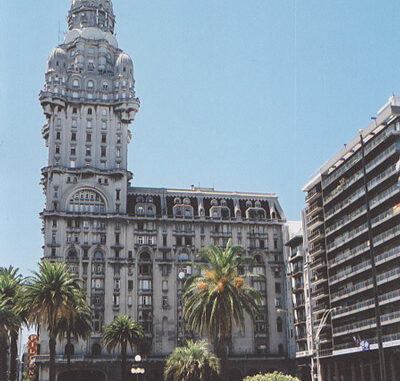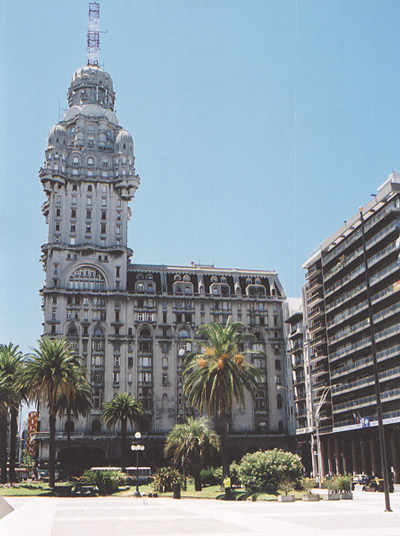

Andrew Payti
Palacio Salvo, Plaza Independencia
Do you enjoy cultural events, history, sports, shopping, lively music, museums, modern and colonial architecture, quaint cobblestone streets, lovely parks and plazas, sparkling water, a busy port, and white-sand beaches? You can find all that and more in the barrios (neighborhoods) of beautiful Montevideo, the capital, main port, and commercial center of Uruguay. Look at a map of Uruguay and you will see that Montevideo is located in the southern part of the country, where the Río de la Plata meets the Atlantic Ocean.
While Montevideo is home to fifty-nine neighborhoods, we will limit our tour to a few barrios that give you a taste of the variety of settings, activities, and culture awaiting you in this wonderful city. Let’s begin our tour in the Centro, the modern downtown area of the city. The main square, the Plaza Independencia, separates the new section of the city from the Ciudad Vieja (Old City) neighborhood. Here stands an impressive statue of General José Gervasio Artigas, the Uruguayan military leader and hero who fought for Uruguay’s independence. He is buried under the statue, and if you are interested, you can descend the steps from the statue to visit his mausoleum. Overlooking the square is the Palacio Salvo, the landmark that at one time was the tallest building in South America.
Just off the plaza is the Teatro Solís, Uruguay’s oldest theater. Built in 1856, it was recently renovated and is a favorite site for cultural events such as operas, ballet, plays, and concerts. At one end of the Plaza Independencia is the beginning of Avenida 18 de Julio, the city’s main thoroughfare. Along it you will find cafés, parks, the interesting Gaucho Museum, and shops where you can buy fine Uruguayan leather. At the other end of the plaza is La Puerta de la Ciudadela (Gateway of the Citadel), the sole remaining part of the old military defense wall that surrounded the city until 1829. Let’s walk through this arch and enter the Old City.
Ciudad Vieja is the interesting historic district where you can experience the history and culture of Montevideo. Walk along the narrow streets and view the variety of architecture—colonial-style houses, modern buildings, and colorful homes in the Barrio Reus. Then walk down Calle Sarandí to the Plaza Constitución, where you can sit at an outdoor café and enjoy drinking yerba mate, Uruguay’s famous herbal tea. You can also visit La Catedral Metropolitana de Montevideo, the city’s oldest building. If you like music and dancing, you will quickly learn that Montevideo is wild about the tango, with it own all-tango radio stations and several tango schools. As you explore, feel free to stop in at one of the many tanguerías and dance the night away! Then, the next morning, continue walking through the Ciudad Vieja and you’ll come to the docks where you can observe the ships and eat fresh fish for lunch at the lively Mercado del Puerto, a dock market full of noisy vendors, local artisans, and street performers.
If you prefer seaside neighborhoods, Montevideo offers a variety of beaches all along its Río de la Plata coast. Playa Ramírez is just a short walk from the Ciudad Vieja. Or you might appreciate a visit to Punta Carretas, a quiet residential neighborhood on the water where you can visit the lighthouse, shop in the shopping center, or—would you believe it—play eighteen holes of golf! Or, you can simply relax and enjoy the view of sparkling water and rocky overlooks. Then, continue to stroll along the rambla, the boardwalk that runs along Montevideo’s coastline. You will come to Pocitos. If you like lively beaches full of young people playing volleyball and other sports, spend the afternoon here!
If you want a different cultural experience, check out the Barrio Sur, the center of Montevideo’s African-Uruguayan community. You have already read about the Uruguayans’ love of tango music. In many of Montevideo’s neighborhoods, but especially in the Barrio Sur, you will experience the musical rhythms of candombe, a uniquely Uruguayan musical rhythm based on the Bantu dances Africans brought to the Americas. Candombe is played on three different-pitched tambores (drums) and sounds a bit like Brazil’s samba. To listen to and watch candombe, go to the Internet where there are fun and colorful videos of this vibrant musical style. Dance to this distinctive music and you’ll be sweating before you know it!
Whether you prefer to visit historic sites and monuments, eat fresh fish and juicy steaks, relax and people watch in a lovely plaza or on a delightful beach, listen to or dance to lively music, or attend a soccer match at the Estadio Centenario, Montevideo has something for everyone! View the following slideshow for colorful images of the places mentioned on our tour and to learn more about them.
Share What You Know:
Does this city remind you of any others you have learned about or visited? Explain the similarities and differences. Is this a city you would like to visit? Why or why not?